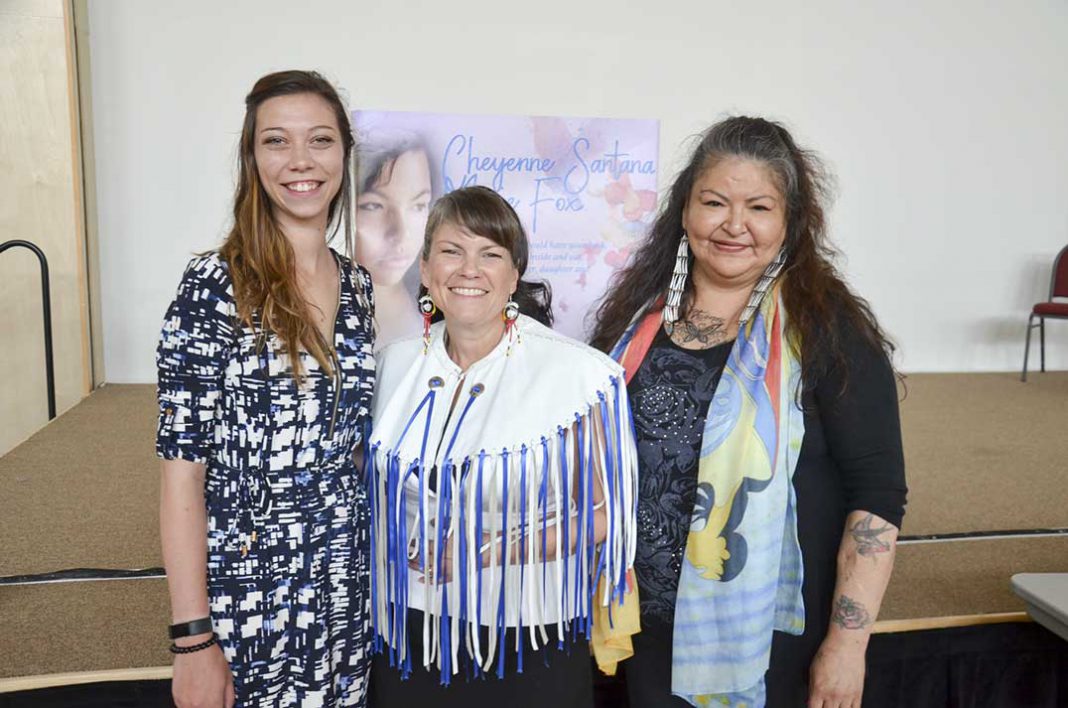AUNDECK OMNI KANING—The pain reverberating through the room was palpable as people reacted to a keynote talk provided to the Violence Against Women and Human Trafficking conference by Dr. Dawn Lavell-Harvard and other speakers, that anger and pain was largely directed against the indifference and complicity of white mainstream society toward the denigration of Anishinabe-kwe of which there were numerous anecdotal and statistical references to back up the charge.
The horror of the subject matter is amplified manifold when one looks behind the statistics that indicate the average age of recruitment as 12. That means for every 14 and 16-year-old there is a corresponding child of eight or 10 who is being suborned into the sex trade. The mind should recoil at the horror, but too often the eyes of those who should be protecting these children are blinded by their skin colour and/or home community and too many others are complicit through their own inaction.
The conference began with a drum song by the Aundeck Omni Kaning (AOK) Hand Drum Group and a prayer by elder Barbara Peltier.
AOK First Nation Chief Patsy Corbiere delivered welcoming remarks, noting that her community is one that prides itself on “looking after our people.”
“There is an overwhelming amount of stuff going on with human trafficking,” said Chief Corbiere. “We need to educate our youth that human trafficking is going on in our back yard and we don’t even know it.”
Chief Corbiere congratulated conference organizer JoAnne Thibideau-Audette for organizing the first ever conference on human trafficking. “This was put together to protect our women and girls and to keep them from being drawn into human trafficking.”
Dawn (Memee) Lavell-Harvard has been involved in the cause of Anishinabe-kwe rights for more than 40 years. “You might say even as a babe in arms,” she laughed, referencing growing up the daughter of famed Anishinabe-kwe rights activist Jeanette Corbiere-Lavell. “I thought everybody’s family went to protest marches and spent evenings making protest signs.”
Ms. Lavell-Harvard related the story of her mother’s battle to regain her rights after being stripped of status after marrying a non-Native while non-Native women marrying Anishinaabe men not only kept their status, but were able to pass it on to their children. “She knew this wasn’t right.”
Coming from a long tradition of strong Anishinaabe-kwe, Dr. Corbiere-Lavell never relented in her battle to gain back her children’s birthright. It is a battle that her daughter has continued to fight as current president of the Ontario Native Women’s Association and director of the First People’s House of Learning at Trent University. She also served as the former president of the Native Women’s Association of Canada and battled relentlessly for the federal government to recognize and act on the disparate number of Indigenous women who had either gone missing or had been murdered.
Dr. Lavell-Harvard delivered a powerful and emotional address to the conference that shone a light on the issue of human trafficking and debunked many of the myths too often promulgated by the very law enforcement agencies that should be protecting women and girls.
Perhaps one of the most powerful messages she brought to the floor was accomplished by turning those law enforcement agencies own statistics around with damning effectiveness.
“They said that Indigenous women were twice as likely to earn income from illegal sources,” she said. “That would be 18 percent versus nine percent for non-Native women. That means that 82 percent of victims did not. They said that they were twice as likely to work in the sex trade, that is 12 percent. That’s 12 percent versus six percent. That means that 88 percent were not involved—so why focus on that? It is an attitude of trying to blame our sisters.”
One interesting statistic that does not often come to the fore is that white women are far more likely to be murdered in their homes.
Dr. Lavell-Harvard did not pull punches. “Our sisters are victims because they were aboriginal and they were female in a community that devalues their lives. They talk about a high risk lifestyle, we are born high risk—not because we chose it.”
She recalled her daughter’s reaction to hearing about the dangers of human trafficking and being Indigenous while they were driving in the car. “My daughter’s eyes were big as saucers,” recalled Dr. Lavell-Harvard. “‘Am I in danger?’ she asked. I wanted with all my heart to tell her no, that I would protect her.” But the truth is that as a young Native girl, she is seen as a choice target for the human traffickers.
Lip service on First Nation women’s issues abounds in the political realm, noted Dr. Lavell-Harvard. “They boast of building 44 new shelters, but what they don’t say is that there are 600 communities where there is no safe place for women and their children to escape abuse.”
The number one reason that women flee their home communities is domestic violence, she said, but when they flee to the big city, those young women quickly discover that it only gets worse. Added to domestic abuse is systemic and pervasive racism.
Behind much of the challenge in children in care comes from a system that does not distinguish between the impacts of poverty and that of abuse. Teachers and other professionals are trained to spot abuse, but those triggers include things like not coming to school with lunch, not having warm clothes in winter. “I go to Giant Tiger to buy a dozen gloves for my children at the start of the school year to replace the ones I know they will lose,” said Ms. Lavell-Harvard. “What about the parent who cannot even afford the first pair?”
One of the lowest common denominators of the missing and murdered, she said, was that of being in the care of the Children’s Aid Society.
On a practical note, Dr. Lavell-Harvard said that one of the key recruiting methods that pimps use to identify potential victims is to walk up to a young Anishinabe-kwe and compliment her hair. “If she says ‘oh I can’t do anything with it’ they know they have someone with low self-esteem to work with, but if they say ‘oh I know, I really love my hair’ they just keep on walking.”
She exhorted her listeners to do whatever they can to build strong and confident children who have a positive self-image as a key defence against the traffickers. She also noted that the taxi industry is often complicit in trafficking rings.
“When a young woman gets into a cab, she should get on her cell phone and call someone, tell them ‘I am in such-and-such cab number and the driver’s name is such-and-such’,” suggested Dr. Lavell-Harvard. That simple expedient will act as a strong deterrent to a would be abductor.
Victim advocate Destiny Douglas also spoke to the assembly. Ms. Douglas, whose own story has been featured in the pages of The Expositor, manages a Facebook page ‘Life After Inspirational’ in support of victims of sexual violence. She was assaulted herself in 2015 and uses her own experience with sexual abuse and domestic violence to help other survivors navigate the legal system and overcome psychological trauma.
Speaker Michelle Atkinson is herself a survivor of human trafficking and a band member with the Couchiching First Nation and was born in Chicago. She spent the first 18 years of her life in foster care and travelled across the continent. She was lured into the sex trade at the age of 12 and was held in its thrall until she was 21. Now a resident of Sheguiandah First Nation, she has earned diplomas in Human Services, Native Mental Health and Business Application. For Ms. Atkinson the tragedy of human trafficking and the missing and murdered has proved generational, as her daughter Cheyenne Santana Fox would eventually be listed among the missing and murdered Indigenous women and girls.
Following the conference, attendees took part in a light dinner/social event and had an opportunity to visit with the many vendors that participated in the conference and which offer services to Anishinabe-kwe and their families.
Throughout the conference a wellness room was available for any attendees that found themselves being triggered by the presentations.





